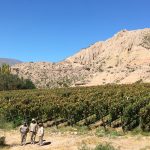What is going on with the argentine vintage wines?
There are plenty of wines around the world that are suitable for cellar ageing, although only a few are famous enough to keep buyers from the temptation of uncorking them. These include Barolos from Piamonte and Bordeaux blends from Médoc, which have truly proven themselves over the past couple of centuries.
But what about other styles and regions? The truth is that a large part of the prestige of producers and terroirs depends upon how well their wines age. The problem is, to find out whether a wine is truly going to make the vintage grade one must wait for a decade or more, and that’s an investment that entails a significant degree of risk.
It’s a tricky question, a kind of chicken and egg conundrum. But in Argentina, the solution doesn’t seem very far away.
Confidence through research
One way in which investors might be persuaded to invest in bottles for the future is if they’re offered some kind of guarantee. Working on that premise the Catena Institute of Wine (CIW) started a series of trials in 2010. The idea was to use scientific methods to determine ageing potential.
That year, 42 Malbec samples were bottled from 26 different vineyards in Mendoza and another 16 from California. The idea was to compare the two, the latter having already established a reputation for ageing well. They were kept in a cellar at the prestigious U.S. DAVIS university and five years later the first samples were analyzed with a chromatograph. They were then tested again 7 and 10 years later.
“The most surprising part was that the Malbecs from Mendoza kept their distinctiveness better than the California wines,” says Fernando Buscema, Director of the CIW. While overall both wines developed well, the Argentine ones didn’t just maintain their character: “The number of volatile composites able to generate aromas is higher in the Mendoza wines than the Californian ones, suggesting that the complexity of Argentine wines is greater than their northern counterparts,” Buscema continues.
He specifically alluded to alfa and beta ionones, which are what produce the violet aromas characteristic of Malbecs from some areas of Mendoza. The CIW’s findings are still being published but the fact that the wine has preserved its terroir over a decade should be enough evidence to tempt collectors.
Argentine vintage wines collections
Of course, not all wines are suitable for ageing. In recent years, for example, we’ve had the privilege of tasting several bottles from the 1970s that are in excellent condition. The 1970s and 80s – when Argentine wineries were aiming at less opulent styles – produced some excellent examples such as Norton Malbec 1974, the first Malbec ever exported; Caballero de la Cepa Cabernet Sauvignon 1978; Weinert Reserva Especial 1977, Trapiche Medalla 1982, Weinert Gran Vino 1983, Lagarde Malbec 1985 and Bianchi 1987.
The Malbecs being made this decade have essentially picked up where they left off. Ripeness is being judged more precisely, as is barrel ageing, producing less oxidative results that are far more promising in terms of cellar ageing. As is true for every region that produces great vintage wines, the key is to get the style right.
The Italian oenologist Alberto Antonini, who runs Alto Las Hormigas, works according to the following hypothesis: ‘Wines from places with plenty of light and low humidity get good, ripe tannins, but they tend to age more quickly in the bottle.” So they need to be treated differently, more carefully, ignoring what’s popular in the market right now, in vessels that inject less oxygen. The barrel is an excellent vessel that works very well in Bordeaux,’ Antonini explains, ‘but here you need to preserve the wine as much as possible so as not to accelerate the ageing.’
Another key factor is making wines in cooler regions. The oenologist and winery owner Susana Balbo says: ‘Because the terroirs of the Uco Valley combine cool temperatures and calcium rich soils, the acid balance is getting more and more refined.’ Balance is another essential variable when determining a wine’s longevity.
And so, the vintage wine scene in Argentina is moving forward by looking back to its past, when wines were made in less extractive styles. Combined with twenty-first century research, the answer to the question of whether it’s worth making a long term investment in Argentine wines is getting ever clearer.




I just opened a bottle of 2010 Viejo Isaias Reserva. Other than having to decant it the aroma and complexity of the wine is magnificent. I have one more remaining and will open it sometime this spring. They were both 2010’s and I wanted to enjoy them with family last year, 2020, which made the wines ten years old. However, the COVID-19 altered all family-food-wine gatherings for the entire year.